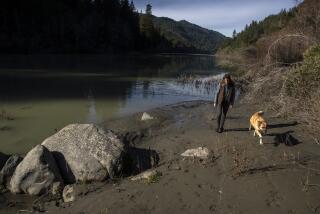Mastodon Fossils Find Resting Place in Library
Fossilized 800,000-year-old mastodon bones, remains of a now-extinct animal that looked like a very large elephant, were discovered on the site of a Palmdale housing project and donated to the city this week.
Paleontologists said the discovery was significant but not unique. Similar remains of mastodons have been found in Southern California, they said, but the Palmdale discovery provides additional confirmation that the desert region had a very different, lusher ecosystem in ancient times.
The 11 pieces of bones were found on the ground in a remote area of Palmdale earlier this spring. The developer donated them to the city so they could be displayed in the city library along with a history of the region.
The pieces, brown and white and ranging from about 2 to 6 inches long, were discovered on an undeveloped 297-acre site where Newport Beach-based Ryder Development is planning a 369-home project, “Desert Mountain.”
“I’m sure most people never thought there were mastodons right here in Palmdale,” said Michael Lawler, a partner in the company. He gave the fossilized bones in a display case to the Palmdale City Council on Thursday night. Most people who saw them said they look like rocks.
Paleontologists said the discovery helps confirm the history of the area around Palmdale, which is on the southern edge of the Mojave Desert. Two million years ago, the area is believed to have been covered with plants and trees and inhabited by antelopes, elephants, saber-toothed cats and camels.
“We expect in many places in California at that time that such animals existed. But expectations and documentation are two different things,” said J.D. Stewart, a paleontologist with the Natural History Museum of Los Angeles County, which acquired other fossil remains found at the site.
Several hundred thousand years ago, however, the region began growing more arid, and eventually many of the larger animals became extinct. “The cause of this mass extinction is one of today’s major mysteries confronting paleontologists,” said a report by the developer’s consultant.
Lawler said he found the bone pieces given to the city while surveying his company’s property in May along with two paleontologists from the Mission Viejo consulting firm of RMW Paleo Associates. The developer was obligated to perform a paleontological assessment of the property as part of an environmental impact report required by the city.
To preserve the area, where other fossil bones had been found, the company agreed to change the placement of its homes. If the project is approved by the city, the areas where bones have been found will be within either a 13-acre park or a 23-acre nature preserve and thus available for exploration, Lawler said.
Scientists believe the ancestors of mastodons, which had curved tusks up to 8 feet long and hairy, reddish-brown coats, came to North America from Asia via a land bridge between Siberia and Alaska as long as 35 million years ago. The last of the creatures died out about 8,000 years ago, scientists believe.
More to Read
Sign up for Essential California
The most important California stories and recommendations in your inbox every morning.
You may occasionally receive promotional content from the Los Angeles Times.









